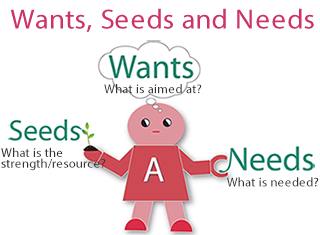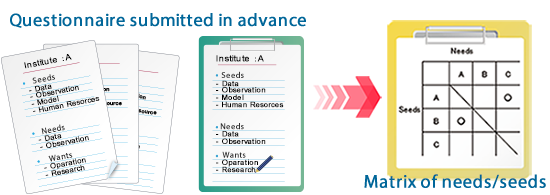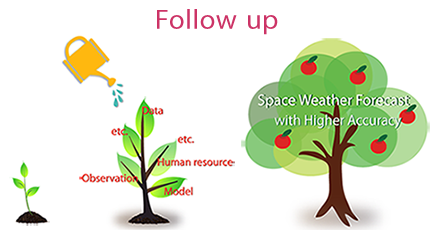
THEME
“International Collaboration on Space Weather Forecast”
Special Session
"Invited Speaker's Speeach"
In the invited speech, the representative of each institute make a presentation regarding "needs / seeds" for the workshop's theme "International Collaboration on Space Weather Forecast".
For example;
Needs:
- What is your purpose of space weather operation/research?
- What is your target in near future in space weather?
- What kinds of data do you want? Which area? How often? For what?
- What kinds of technique do you want to learn?
- With which countries/institutes do you want to collaborate? etc.
Seeds:
- What kinds of resources do you provide: model code? observation data?
measurement technique? human resources? observational field? etc.
AOSWA aims to grow up the discussion about the cooperation during and after the workshop.
Discussion Time (Omiai Time)
Following the Special Session, we would like to discuss how to build the collaboration in all. As a trial, we will have a "game" for promoting new relation among the participants of AOSWA-3 which will grow future international cooperation.
In Japanese traditional custom for finding marriage partner, we have an "Omiai" system. As the process of making cooperative project is similar to Omiai, we try to follow the scheme of Omiai for the AOSWA discussion.
- SOC will send a questioner to invited speakers in which we ask their needs, seeds and wants. Participants should prepare some options in each item for answering easily.
- On the base of this questionnaire, SOC will prepare the matrix of needs/seeds
- Using this table, each institute has a small meeting with the potentially matching partners. the meeting time should be limited (15-20 min) SOC keeps the time. Each institute will have three potential partner institutes. In addition they can choose another one which they like.
- After the meeting we have plenary meeting for discussing the results.
- We should follow up the results in future AOSWA WS.





What is Space Weather Event Report?
"Preliminary Analysis of Latest Events"
This activity is promoting collaborative analyses of observation and simulation data to study the cause-effect activities from the Sun to the Earth based on latest space weather events. Latest three or four scientifically interesting events are selected for detailed analysis. Presentation of analysis on the past remarkable geoeffective events is also welcome.
- Overview of solar-terrestrial environment between June, 2014 and March, 2015
Sunspot number has increased again since the beginning of 2013 and seems to become maximum in the middle of 2014. In October, a sunspot group, NOAA/AR12192 appeared and produced many M-class and X-class flares. However, this active region did not produced any solar energetic particle events and geomagnetic storms. Geomagnetic activities are still low comparing with recent several cycles. During this period, there is no geomagnetic storm with Dst-index value less than -100 nT except for the storm of January 7, 2015. Enhancement of high-energy electron flux at geosynchronous orbit was observed associated with the September 27-30 geomagnetic storm. Several Dillinger Phenomenon by M-class and X-class flares were observed by domestic ionosonde observations. Ionospheric negative storms occurred associated with geomagnetic storms. - Selected events for detailed analysis
- Slow CMEs and high speed solar wind following the CMEs: August 27-30, 2014 geomagnetic storm and related activities with this storm
Geomagnetic storm gradually started around 03UT on 27 August, 2014. This geomagnetic storm was caused by slow CMEs on 22. High speed solar wind from isolated coronal hole around solar equator followed the CMEs. Negative ionospheric storm occurred associated by this geomagnetic storm. - IMF direction of CME and its effect: September 12-13, 2014 geomagnetic storm and related activities with this storm
NOAA/AR12158 produced a M4.5/1N long duration event (LDE) flare with a full halo CME. Enhancement of solar energetic particles by this flare was observed by NOAA/GOES satellite. Arrival of an interplanetary shock was observed at 1554UT on 12 September, 2014 at Kakioka as Sudden Storm Commencement (SSC). Interplanetary magnetic field (IMF) was mainly directed northwards. As the result, intensity of geomagnetic storm was relatively small. Enhancement of high-energy electron at geosynchronous orbit and negative Ionospheric storm occurred associated with this geomagnetic storm. - Large active region without CMEs:Activities of NOAA/AR12192
NOAA/AR12192 had area larger than that of AR10486 at the moment of the Halloween event in October, 2003 and produced many M-class and X-class flares. However, solar energetic particle events and geomagnetic storms were not produced by activity of AR12192. AR12192 appeared as AR1273 in the previous rotation and returned as AR112209 and produced several M-class flares in the next rotation. - Hyder flare associated with a large filament eruption: Enhancement of solar energetic particle flux between 1 and 4 November, 2014 and a weak geomagnetic storm on 4 and 5 November
A large filament eruption occurred between 04UT and 06UT on 1 November, 2014. A Hyder flare was observed associated with this filament eruption. Enhancement of solar energetic particle flux started several hours after this flare. A weak geomagnetic storm associated with this event occurred between 4 and 5 November.

